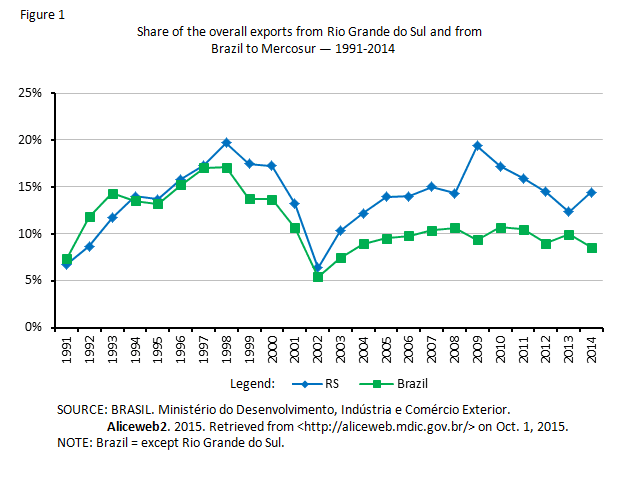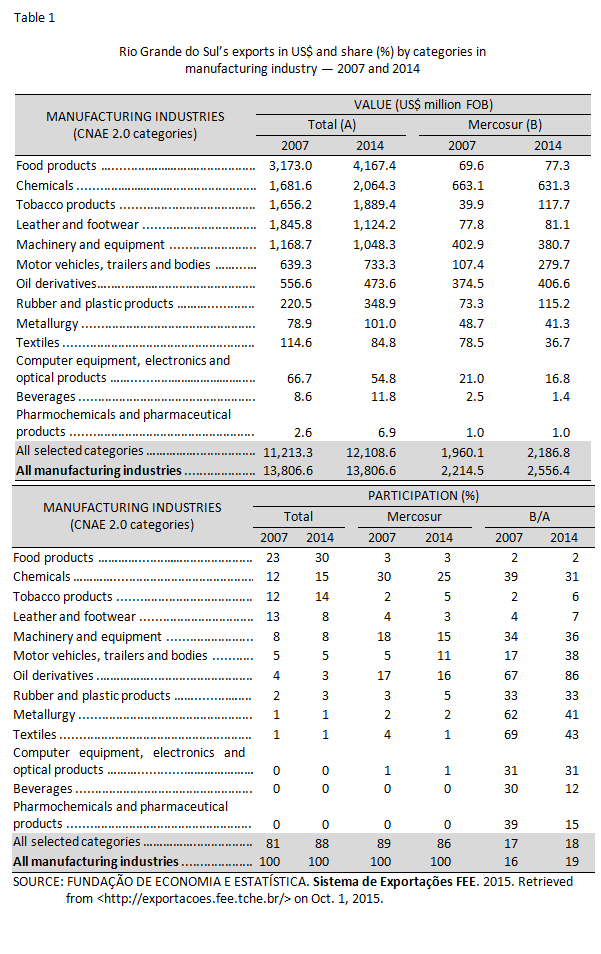The location of Rio Grande do Sul in Southern Brazil, regarded as “eccentric” by many, due to its distance from the country’s main consuming centers, becomes central when it comes to Mercosur. After all, the shared borders with Uruguay and Argentina give the state a privileged position for strengthening production and trade ties between the bloc’s countries and Brazil. Initially perceived as a threat to the state’s economy, given the productive similarities with the neighboring countries (mainly because of the relevance of agribusiness), Mercosur has become a factor for attracting investments to Rio Grande do Sul. In that crop of investment, achievements can be seen in the automotive industry, which has witnessed the creation of a regional division of labor involving complementarities and interdependences between the products manufactured in Brazil and those made in Argentina. The same can be said of the agricultural machinery sector, whose location in the state has proven strategic for meeting the needs of both the neighboring countries and the growing demand of the Brazilian midwest. From the start, Mercosur posed a strategic opportunity for a structural transformation in the state’s production structure.
[…] the integration with the countries in the southern part of the continent has proven to be able to change the major features of the state’s economy. Indeed, the state is starting to leave behind its historical peripheral condition in Brazil to play a central role within the integrated economy. Investment decisions which reflect and materialize such ongoing change are starting to be made and tailored to meet the needs of Mercosur.[1]
After more than 25 years since its creation, Mercosur still plays a strategic role in the state’s economy, although the opportunities and expectations about the bloc’s future are less promising.
The state’s economy is more open to Mercosur than the national average due to the built production complementarities and the higher share of imports, whose front door is the state and whose destination is often the center region of Brazil (Figure 1). On average, between 1991 and 2014, sales to Mercosur accounted for 14% of Rio Grande do Sul’s exports and 11.2% of the ones from Brazil. As regards imports, in the same period, Mercosur was responsible for 32.5% of the state’s foreign purchases and 9.8% of Brazil’s .
When comparing the state’s exports towards Mercosur with those towards other regions, the relevance of the bloc becomes even more evident (Figure 2). Throughout almost the entire period between 1991 and 2014, Mercosur was the third main destination of the state’s exports. The average share of the export value was only surpassed by the European Union (22.8%) and the U.S. (19.9%). However, their relevance in the exports of Rio Grande do Sul has been reducing significantly in recent years.
Considering each bloc member, for the period 1991-2014, on average 62% of the exports were directed to Argentina, 19% to Paraguay and 18% to Uruguay. From 1991 to 2009, the exports of Rio Grande do Sul to Mercosur increased in value at an average annual rate of 15%, while the overall state’s exports expanded in 9%. More recently, however, a sensible change can be noticed: the state’s sales to the bloc member countries shrank 2% between 2010 and 2014, while the state’s total exports grew 4%. This change reflects primarily a decrease of 9% in the sales to Argentina in the period.
The relevance of Mercosur for the state’s economy, at least when it comes to international trade, becomes even clearer when the composition of the exports to the bloc is disaggregated. By analyzing the state’s exports in a more recent period (2007-14) and by aggregate factor, we can notice that the composition of the export basket of Rio Grande do Sul to the world (Figure 3) is predominantly commodity-driven (average of 52%), while the sales to Mercosur (Figure 4) largely comprise manufactured products (92%), which shows a very contrasting pattern.
A similar pattern can be seen when we classify the state’s exports by technological intensity. Medium-high and medium-low technology goods comprise a larger share of the exports to Mercosur, while the exports to other destinations have a greater share of nonindustrial and low-technology items. In 2014, medium-high and medium-low technology goods made up approximately 80% of the sales to Argentina and Uruguay. On the other hand, over 70% of the exports to European countries consisted of low-tech or non-industrial products, a percentage that exceeded 90% in the case of the exports to China. To the United States, the share of medium-high and medium-low technology products was 42% in the same year. However, the U.S. participation in the state’s exports has been consistently decreasing, as can be seen in Figure 2.
Therefore, Rio Grande do Sul’s exports to the Mercosur nations comprise mainly industrial products with some degree of technological intensity. The importance of such products is also revealed in the greater income-elasticity of the demand and in the high potential of long-term growth. These products also tend to be less subject to the deterioration of the terms of trade, less susceptible to substitutes in the world market and more demanded by more dynamic markets. In this case, Mercosur can be seen as an exception to the structure of the export basket of Rio Grande do Sul, which is highly concentrated in low value-added products. Thus, the proximity of the state’s economy to that of the Mercosur member countries — and the very existence of the bloc — contributes to the diversification and the quality of the state’s exports, offsetting the competitive difficulties associated with the export of manufactured goods to other regions.
As for the sectorial activity in the state’s exports to Mercosur (Table 1), a strong participation of chemicals, machinery and equipment and motor vehicles can be underlined. Mercosur is also a major destination for the products of other industries with lower participation in the state’s exports, such as petroleum products, textiles, metal products, rubber and plastic products, computer equipment and electronics. The exceptions — some of the important state’s exports of which Mercosur does not represent a relevant share — are food products, tobacco products, leather and footwear. Regarding the share of exports in the total production, the chemical and textile sectors direct much of their production to Mercosur. In the other sectors, Brazilian market and exports to other countries and blocs are more relevant.
As can be perceived from the discussion above, the last few years have been characterized by difficulties in the trade and production relations within the bloc, to which the economic problems faced by Argentina have greatly contributed. These difficulties do not stem only from the slowdown in the growth rates and from the high inflation in that country, which inevitably impact on its imports. They especially reflect the scarcity of foreign exchange in the face of the still poor access to external financing flows, a legacy from the crisis of the end of the convertibility plan in the early 2000s. More recently, the shortage of foreign exchange in Argentina has worsened, owing to the cooling of soybean prices in the world market. In that scenario, the crisis in the neighboring country has affected the performance of Rio Grande do Sul’s exports not only because of the drop in imports, but also because it has induced, even temporarily, the adoption of control policies over the granting of import licenses and the establishment of quotas.
Furthermore, the Government of Argentina has also been adopting structural measures aimed at overcoming the shortage of foreign exchange in the long run. They involve reissuing an import substitution policy — already evident in the agricultural machinery sector, given the “[…] change of the neighboring country from the main foreign customer into a competitor in South American and African markets”[2] — and broadening partnerships with China, in order to finance infrastructure projects in exchange for a greater opening for the manufacturing market of that Asian country. As a result, there is an increasing market share of Chinese manufactured goods imported by Argentina and a greater propensity for Brazil to adhere to bilateral trade agreements, which questions many economic advances achieved thanks to the bloc. Considering that an important part of the industry established in Rio Grande do Sul aims to occupy a strategic and central position simultaneously for Brazil and the Mercosur markets, the difficulties of the bloc also result in the loss of crucial competitive advantages for attracting investments to the state.
[1] CASTRO, A. B. Notas para uma estratégia. In: RIO GRANDE DO SUL. Secretaria de Coordenação e Planejamento (SEPLAG). Projeto RS 2010: realizando o futuro. Porto Alegre, 1998. p. 10. Translation mine.
[2] FEIX, R.; DE GASPERI, E. Argentina substitui importações de máquinas agrícolas. Carta de Conjuntura FEE, Porto Alegre, v. 23, n. 12, p. 1, dez. 2014. Translation mine.






